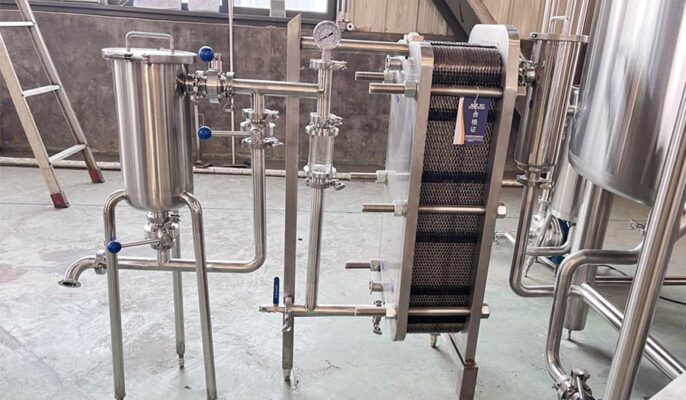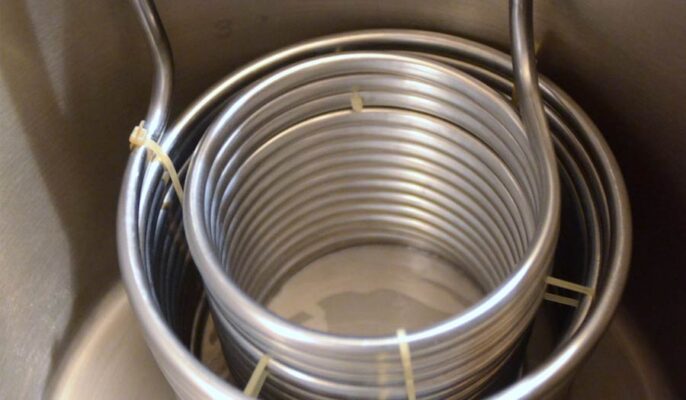Cooling the wort is an important step in brewing beer, and the wort chiller is one of the essential pieces of equipment in a brewing facility. Brewing beer is a meticulous process that relies on precise temperature control at all stages. After boiling, the wort needs to be cooled. Cooling should be done as soon as possible as there is a risk of infection.
What is a wort cooler?
A wort cooler is a device used in the brewing process that allows homebrewers to bring boiling wort down to yeast-pitching temperature in a fraction of the time required for an ice bath. These devices come in a variety of shapes and sizes to suit your needs and the batch size you are brewing.
In beer brewing, boiling wort needs to be quickly cooled down to a temperature range suitable for the yeast to carry out the fermentazione process that follows. The wort cooler removes heat from the boiling wort using different operating principles, such as heat exchange and cools it down quickly. This ensures that the yeast is fermenting at the right temperature and also helps to prevent bacterial contamination and maintain the quality of the beer. Wort coolers play a vital role in the brewing process and have a significant impact on the quality of the final beer.

Why are wort chillers so important in brewing?
Wort is the medium through which yeast ferments sugar, converting it into alcohol and carbon dioxide. This primary fermentation process ultimately transforms the wort into beer, which develops its unique flavor and character.
Wort coolers are used to cool new beer quickly and efficiently. This is because water cooling takes place directly after the boiling of malt, water, and hops. But of course, the most important ingredient is still missing: the yeast. The wort can only really be transformed into beer when the yeast starts the fermentation process, which produces alcohol, aromas, and carbon dioxide. However, after boiling, the temperature of the wort is about 100°C, which is too hot for the yeast because the yeast culture dies immediately.
It is important to cool the wort to below 80°C as soon as possible after boiling, as this is the time when the wort is most susceptible to bacterial contamination. A wort chiller minimizes the chance of infection and helps produce a clearer beer because it helps promote cold breakdown. Cold breakdown consists of protein and tannin complexes that become insoluble as the temperature of the wort drops, meaning that these solids drip off the liquid as the wort is transferred from the pot to the fermenter. Essentially, good cold breakdown means clearer beer.
Principle of the wort cooler
Wort coolers typically utilize the principle of heat exchange, whereby the temperature of the wort is rapidly lowered by bringing the boiling wort into contact with a cooling medium (usually cold water or coolant) for heat transfer.
The main types of cooling include:
- Plate heat exchangers: plate heat exchangers consist of a series of plates attached to a large frame. Spacers placed around the edges of the plates maintain the spacing between each plate. Each corner of the plates has four openings, and the shims are placed in such a way that hot and cold fluids flow alternately between the plates. Plate and frame heat exchangers are very efficient at transferring energy because of the large surface area of the plates and the fact that the plates can be made of very thin materials.
- Shell and Tube Heat Exchanger: A tube heat exchanger consists of a series of tubes arranged in parallel. The boiling wort flows through the interior of the tubes while the cooling medium flows through the exterior of the tubes, where heat exchange is achieved by heat transfer through the walls of the tubes.
- Shell & Tube Heat Exchangers: While various configurations are available, the basic and most common design consists of a series of stacked spiral coils. The tube ends are connected to a manifold, which acts as an inlet and outlet location for the fluid. The tube bundle consists of several stacked tubes, with the entire bundle placed inside the housing. The number of tubes (coils) as well as their spacing and length may vary to effectively optimize thermal and hydraulic requirements.
These heat exchangers differ slightly in construction, but they all share the basic principle of heat exchange by heat transfer to rapidly cool the boiled wort to the proper fermentation temperature.
The Role of the Wort Chiller
Rapidly cooling wort has several benefits, both in terms of enhancing flavor and controlling bacteria. First, rapid cooling helps produce a sharper, more defined flavor profile. Preserving delicate hop compounds and preventing undesirable chemical reactions results in a beer with greater complexity and balance.
- Controls the yeast fermentation temperature: Yeast can only ferment optimally within a specific temperature range; too high or too low a temperature can affect the fermentation. A wort cooler rapidly cools the boiled wort to the proper fermentation temperature, ensuring that the yeast is fully active and efficiently converting sugar into alcohol and carbon dioxide.
- Avoiding bacterial contamination: The process of boiling wort may kill most bacteria, but it does not eliminate all microorganisms. Hot wort is an ideal breeding ground for bacteria, leading to off-flavors, spoilage, and even potential health risks. This risk can be minimized by quickly cooling the wort to ensure a clean and tasty end product.
- Locking in flavor and texture: The speed at which the wort is cooled also affects the texture and flavor of the final product. Cooling too quickly or too slowly can lead to differences in yeast metabolites, which can affect the flavor and mouthfeel of the beer. Wort chillers control the cooling rate and help brewers achieve their desired flavor and mouthfeel.

Methods for cooling wort quickly
During the cooling process, it is important to consider the method used. There are a variety of available techniques, including immersion cooling, plate cooling, and countercurrent cooling. Each method has its advantages and disadvantages and the choice depends on factors such as batch size, available equipment, and personal preference.
Immersion Cooling
Immersion cooling involves immersing the coil or heat exchanger directly into the wort. This method is relatively simple and cost-effective, making it a popular choice for home brewers. However, this method can be time-consuming, especially for large batches of beer, and may require large amounts of water for cooling.
Plate Cooling
Plate cooling utilizes a series of stainless steel plates to transfer heat from the wort to a cooling medium such as water or glycol. This method is highly efficient and allows for rapid cooling of the wort. However, this method is costly and requires regular maintenance to prevent clogging and ensure optimal performance.
Counterflow cooling
Counterflow cooling involves passing hot wort through pipes while reversing the flow of cold water. This method allows for efficient heat exchange and precise temperature control. However, it can be more complicated to set up and may require additional equipment (e.g., pumps) to achieve the proper flow rate.
Common mistakes in wort cooling
- Cooling too slowly: If the wort is cooled too slowly, it may cause the yeast to die or be inactivated in the overheated wort, which can affect the fermentation process. In addition, slow cooling increases the risk of microbial recontamination. Therefore, it is very important to ensure that the wort can be cooled quickly in a short period.
- Uneven cooling: Sometimes when using a wort cooler, uneven cooling may occur, resulting in higher temperatures in some areas of the wort and lower temperatures in others. This can lead to uneven fermentation, producing inconsistent textures and flavors.
- Use of unclean cooling media: The use of unclean cooling media (e.g. contaminated water) may result in contamination of the wort, which can affect the quality of the final beer. Therefore, it is important to ensure that a clean, contamination-free cooling medium is used during the wort cooling process.
- Excessive stirring: Excessive stirring of the wort may introduce air and increase the risk of oxidation. While oxidation is expected in some types of beer, in others it can lead to undesirable flavors, so care needs to be taken with the intensity and duration of stirring.
- Neglecting post-cooling treatment: Immediately after cooling the wort, it needs to be transferred to the fermenter and subsequently processed. If the wort stays too long after cooling, it may increase the risk of microbial contamination or cause other undesirable effects.
- Unsuitable cooler selection: Selecting an unsuitable wort cooler may result in inefficient cooling or failure to meet brewing requirements. Therefore, when selecting a wort cooler, factors such as brewing scale, equipment quality, and performance need to be considered.
Conclusione
Wort coolers play an important role in brewing. Wort is the foundation of beer production and affects the flavor, aroma, and stability of beer. By understanding the importance of efficient cooling methods, brewers can improve the quality of their beer, enhance flavor, and prevent contamination.




